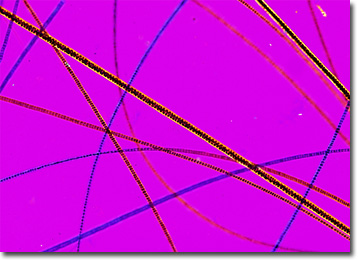Polarized Light Microscopy Digital Image Gallery
Ermine Hair
The term ermine is commonly utilized to refer to several species of weasel that inhabit northern areas of North America, North Africa, and Eurasia. Small, but voracious, ermines typically eat over 40 percent of their body weight in a single day.

During the winter in cold climes, the fur of ermines, which is at other times of the year predominantly brown, turns white, except for a black spot at the end of the tail. In areas that are a bit warmer, however, the coat of the animal only turns partially white. It is the principally white winter pelt of the ermine that is in great demand within the fur industry, where the soft, lush, highly valuable hair is often utilized to fabricate coats, stoles, and trimmings. In fact, the admiration of and desire for white ermine fur extends back many centuries. The tails of the animals were, for instance, utilized as ornamentation by the warriors of certain Native American tribes, and in England during the years that Edward III inhabited the throne (1327-1377) ermine fur was considered so luxurious that it could only be worn by the royal family.
Similar to other weasels, ermines possess very short limbs, large eyes, prominent snouts, and long, lithe bodies. Most grow about 10 inches long excluding the tail, which may add another few inches in length, and weigh less than 7 ounces. Inquisitive and ferocious, ermines are excellent hunters that subsist primarily upon mice and other small rodents, birds, eggs, and invertebrates. Using their keen sense of smell to locate prey, they are able to capture them by either attacking the throat or by grasping them at the base of the neck. During the day, the primarily nocturnal animals usually rest inside of burrows, often those that have been abandoned by other animals.
